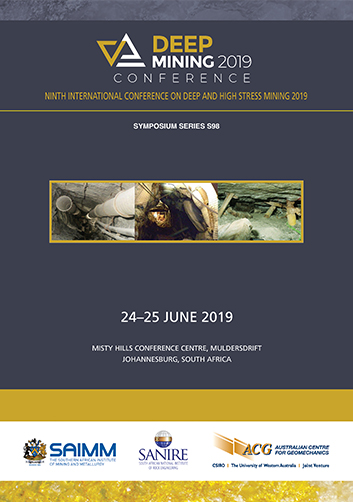Accounting for rock mass heterogeneity and buckling mechanisms in the study of excavation performance in foliated ground at Westwood mine

|
Authors: Bouzeran, L; Pierce, M; Andrieux, P; Williams, E |
DOI https://doi.org/10.36487/ACG_rep/1952_03_Bouzeran
Cite As:
Bouzeran, L, Pierce, M, Andrieux, P & Williams, E 2019, 'Accounting for rock mass heterogeneity and buckling mechanisms in the study of excavation performance in foliated ground at Westwood mine', in W Joughin (ed.), Deep Mining 2019: Proceedings of the Ninth International Conference on Deep and High Stress Mining, The Southern African Institute of Mining and Metallurgy, Johannesburg, pp. 29-44, https://doi.org/10.36487/ACG_rep/1952_03_Bouzeran
Abstract:
Operations at Westwood mine in Quebec, Canada, were temporary halted in May 2015 after three large-magnitude seismic events occurred over two days. The mechanisms leading to these events, which caused severe damage to several accesses, were not well understood at first. This was partly due to the complex geology at the site, where massive, unaltered, strong, brittle, and seismically active rock can alternate with highly altered, weak, foliated, and buckling-prone rock at the meter scale. Other ground behaviours such as the significant discrepancy in blasthole performance between secondary and primary stopes and the propagation of damage from stopes to haulage drives in some locations were also not well understood. In 2017, further geotechnical characterization of the rock mass was carried out and numerical back-analyses of several locations were completed using the continuum code FLAC3D. The objectives of the back analyses were to better understand the mechanisms controlling rock mass performance and to obtain a calibrated model for predictive stoping simulations. This paper presents the key aspects of the modelling, which include: (1) An anisotropic rock mass strength model with properties derived from field and lab strength testing, and (2) a scheme to account implicitly for the deconfinement that accompanies buckling around excavations.
References:
Blake, W., Kaiser, P.K. and Simser, B. (2015). Rockburst Review Committee Report, Supplementary Technical Report, Submitted October 5 2015. Westwood Mine, IAMGOLD.
Board, M. and Pierce, M. (2009). A review of recent experience in modelling of caving. Proceedings of the International Workshop on Numerical Modeling for Underground Mine Excavation Design and 43rd U.S. Rock Mechanics Symposium. NIOSH Pittsburgh Research Laboratory.
Clark, I. H. (2006). Simulation of Rockmass Strength Using Ubiquitous Joints. Proceedings of the 4th International Symposium on Numerical Modeling in Geomechanics. Hart R. and Varona P. (eds). Itasca Consulting Group, Inc. Paper No. 08-07.
Hoek, E., C. Carranza-Torres and B. Corkum. (2002) “Hoek-Brown Failure Criterion - 2002 Edition,” in NARMS-TAC 2002: Mining and Tunnelling Innovation and Opportunity, Vol. 1, pp. 267-273. R. Hammah et al., Eds. Toronto: University of Toronto Press.
IAMGOLD (2017a) “Mineralization and geology of the Westwood deposit,” – PowerPoint presentation for internal communication, 56 slides, January 2017.
IAMGOLD (2017b) “Westwood Background Presentation,” – PowerPoint presentation for internal communication, 101 slides, January 11 2017.
IAMGOLD (2015) “Analysis of May 26th Seismic Events and General Seismicity at Westwood Mine,” – PowerPoint presentation, Peer Review September 25-26 2015, 162 slides, September 2015.
Itasca Consulting Group, Inc. (2016) 3DEC — Three-Dimensional Distinct Element Code, Version 5.2. Minneapolis: Itasca.
Itasca Consulting Group, Inc. (2017) FLAC3D — Fast Lagrangian Analysis of Continua in 3 Dimensions, Version 6.0. Minneapolis: Itasca.
ISRM (1984). Suggested Method for Determining Point Load Strength. ISRM: Point Load Test, RTH 325-89, June 10,1984.
Kalenchuk, K.S., Mercer R., Williams E. (2017). Large-magnitude seismicity at the Westwood mine, Quebec, Canada. Proceedings of the Eighth International Conference on Deep and High Stress Mining. Wesseloo J. (ed.). Australian Centre for Geomechanics, Perth, ISBN 978-0-9924810-6-3.
Karampinos, E. (2016) “Management of Squeezing Ground Conditions in Hard Rock Mines”. PhD Thesis, Department of Civil Engineering, University of Toronto.
Lorig, L. and M. Pierce. (2000). Methodology and Guidelines for Numerical Modelling of Undercut and Extraction Level Behaviour in Caving Mines. Itasca Consulting Group Inc., Report to the International Caving Study.
Mercier-Langevin, F., Hadjigeorgiou, J. (2011). Towards a better understanding of squeezing potential in hard rock mines. Mining Technology, 120(1), 36-44.
Mercier-Langevin, F., Wilson, D. (2013). Lapa Mine – ground control practices in extreme squeezing ground. Proceedings of the Seventh International Symposium on Ground Support in Mining and Underground Construction. Potvin Y. and Brady B. (eds). Australian Centre for Geomechanics, Perth, pp. 119-131.
Pierce, M. (2013). Numerical Modeling of Rock Mass Weakening, Bulking and Softening Associated with Cave Mining. ARMA e-newsletter. ARMA publications committee, spring 2013.
Potvin, Y., Hadjigeorgiou, J. (2008) “Ground support strategies to control large deformations in mining excavations,” Journal of the South African Institute of Mining & Metallurgy, 108(7), 397-404.
Sainsbury, Bre-Anne & Pierce, M & Mas Ivars, Diego. (2008). Simulation of Rock Mass Strength Anisotropy and Scale Effects Using A Ubiquitous Joint Rock Mass (UJRM) Model. Proceedings of the First International FLAC/DEM Symposium on Numerical Modeling, (Continuum and Distinct Element Numerical Modeling in Geo-Enginnering). Hart R., Detournay C. & Cundall P. (eds.). Itasca Consulting Group, Inc., Minneapolis, Paper: 06-02.
© Copyright 2025, Australian Centre for Geomechanics (ACG), The University of Western Australia. All rights reserved.
View copyright/legal information
Please direct any queries or error reports to repository-acg@uwa.edu.au
View copyright/legal information
Please direct any queries or error reports to repository-acg@uwa.edu.au